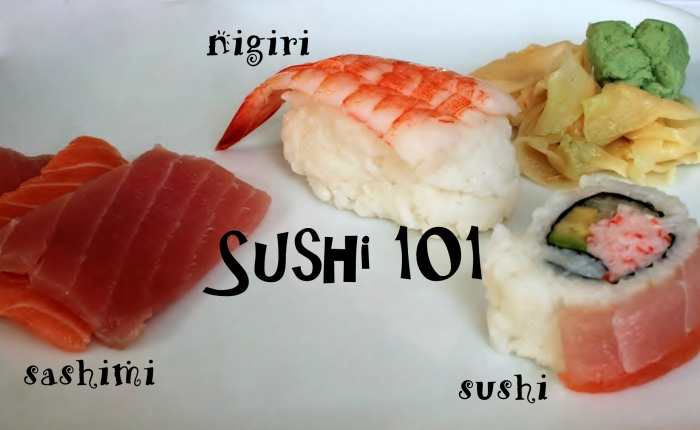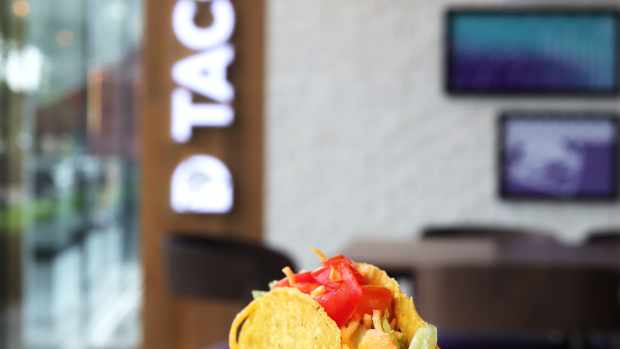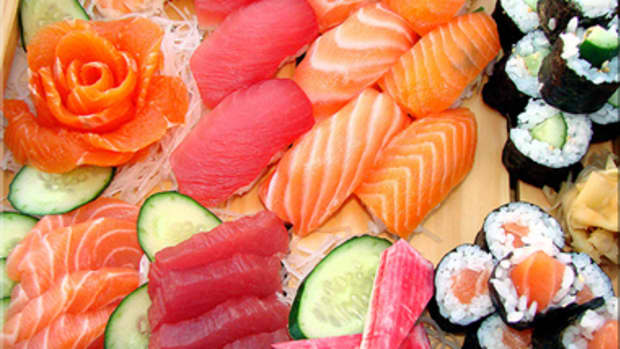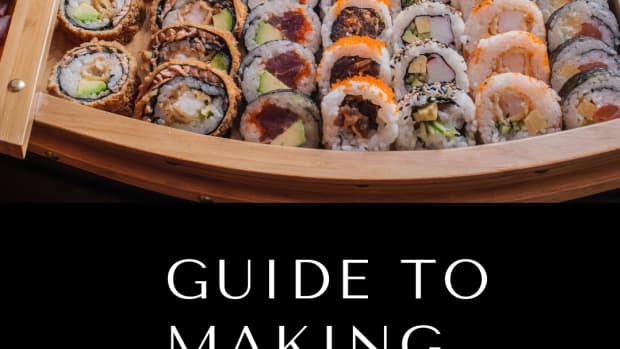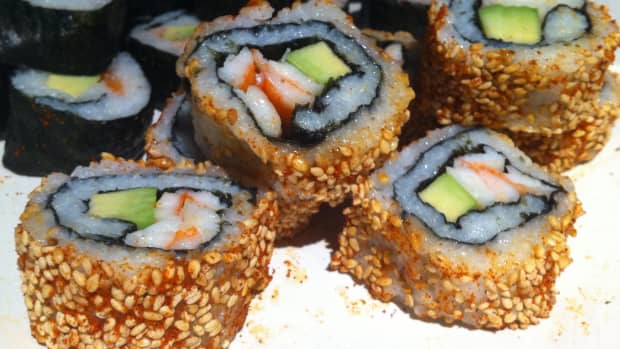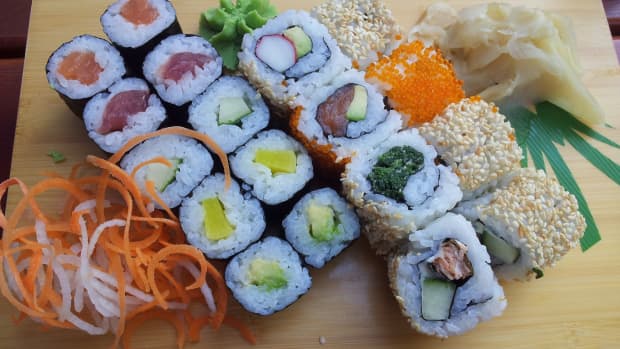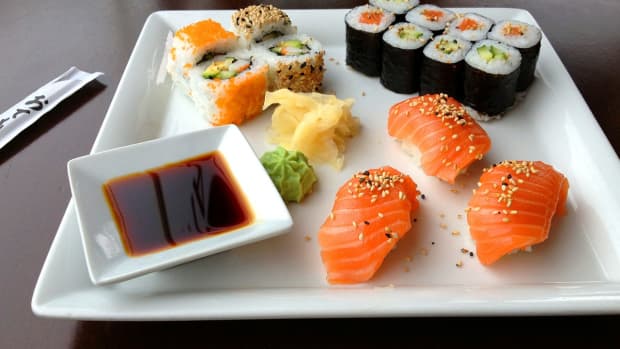The Different Kinds of Sushi: Types, Names, and Photos
Types of Sushi
If you didn't grow up eating sushi, you may be confused when looking at a sushi roll menu if the restaurant chooses to leave out the descriptions. This guide will break down some common sushi terms and recipes so you can know what to order when visiting a sushi bar or restaurant.
Did You Know?
Feel free to eat your sushi rolls or nigiri with your hands! This is, in fact, how many in Japan eat their sushi. When eating nigiri, it's also recommended to turn the roll upside-down to dip in soy sauce to avoid absorbing too much into the rice.
5 Main Types of Sushi
| Type of Sushi | Description | Notes |
|---|---|---|
Nigiri | A topping, usually fish, served on top of sushi rice | Not all nigiri is raw, though this dish is best for people who want to appreciate the flavor of the fish, shellfish, or other toppings |
Sashimi | Fish or shellfish served alone (no rice) | This is best for people who really love to taste the fish or shellfish since it comes with nothing else |
Maki | Rice and filling wrapped in seaweed | This is what most people think of when they think of sushi rolls |
Uramaki | Similar to the above, but rice is on the outside and seaweed wraps around the filling | These rolls often have lots of toppings and sauces — they may either be cooked or raw |
Temaki | Sushi that has been hand-rolled into a cone shape | The cones are not as easy to share as the rolls (though very delicious!) |
Here's a brief run-down on what's what. For pictures and more information about each type, you can scroll to the sections below.
What's the Difference Between Sushi, Sashimi, and Nigiri?
- Sashimi is just the meat, served without other ingredients.
- Sushi features the meat and adds rice and other ingredients, such as vegetables, which are all rolled up in a sheet of nori (seaweed) and then sliced into pieces. You'll either see it as maki (which means roll), where the seaweed is on the outside, uramaki, where the seaweed is on the inside and rice is on the outside, or temaki, a cone-shaped piece of sushi that's rolled by hand.
- Nigiri is a dish that's halfway in between sashimi and sushi. Nigiri is sashimi that's served on a molded rectangle of rice.
Lastly, while most sashimi is raw fish, some sashimi is not raw, and some sashimi is not fish. For example, unagi is cooked freshwater eel, and sashimi also encompasses other types of seafood, which you will see below.
Types of Sashimi
| Sashimi Name | What Is It? |
|---|---|
Ahi | Tuna (raw) |
Aji | Spanish Mackerel (raw) |
Amaebi | Sweet Shrimp (raw) |
Anago | Saltwater Eel — usually deep-fried or boiled |
Aoyagi | Round Clam (raw) |
Bincho | Albacore White Tuna (raw) |
Katsuo | Skipjack Tuna (raw) |
Ebi | Tiger Shrimp (cooked) |
Escolar | Butterfish (raw) |
Hamachi | Yellow Tail (raw) |
Hamachi Toro | Yellowtail Belly (raw) |
Hirame | Halibut (raw) |
Hokigai | Surf Clam (cooked) |
Hotate | Scallop (raw) |
Ika | Squid (the body is served raw, the tentacles are cooked) |
Ikura | Salmon Roe (fish eggs) |
Iwashi | Sardine (raw) |
Kani | Crab Meat (cooked) |
Kanpachi | Amberjack (raw) |
Maguro | Tuna (raw) |
Saba | Mackerel (raw) |
Sake | Salmon (raw) |
Sake Toro | Salmon Belly (raw) |
Tai | Red Snapper (raw) |
Tako | Octopus (cooked) |
Tamago | Sweet Egg Omelet (cooked) |
Toro | Blue Fin Belly (raw) |
Tsubugai | Whelk Clam (raw) |
Umi Masu | Ocean Trout (raw) |
Unagi | Barbequed Freshwater Eel |
Uni | Sea Urchin (raw) |
Sashimi is to sushi as a fillet is to a taco. Any sashimi meat can be made into a sushi roll. And any chef can get creative and create specialty sushi rolls by combining multiple meats and vegetables. However, there are a few specialty sushi rolls that can be found at most restaurants, though the exact preparation can differ significantly.
Types of Popular Sushi Rolls
| Roll Name | What's in It? | Contains Raw Fish? | You Should Order If . . . |
|---|---|---|---|
Tiger Roll | Avocado, shrimp tempura, cucumber, tobiko (flying fish roe — fish eggs) | Usually not — double check to make sure | You like fried shrimp and avocado |
Philadelphia Roll | Salmon, avocado, cream cheese | Yes | You like cold and creamy |
Crunch Roll | Spicy tuna, crispy seaweed, tempura | Yes | You like crispy, crunchy and raw tuna |
Dynamite Roll | Shrimp tempura, yellowtail, bean sprouts, carrots, avocado, cucumber, chili, spicy mayo | Sometimes | You like warm, creamy, and crunchy |
Rainbow Roll | Fish cake/imitation crab, avocado, cucumber, tuna, avocado, salmon, shrimp, yellowtail | Yes | You like different kinds of sashimi |
Dragon Roll | Eel, crab, cucumber / avocado outside, eel sauce | Sometimes | You love eel — which is warm, buttery, and a little sweet |
California Roll | Crab or imitation crab, avocado, cucumber, sesame seeds | No | You don't like raw fish and like avocado |
Spicy Tuna Roll | Tuna, mayo, chili sauce | Yes | You like cold and spicy |
Caterpillar Roll | Eel, cucumber, avocado | No | You like eel (cooked and warm) and avocado |
Spider Roll | Soft-shell crab tempura, cucumber, avocado, spicy mayo | No | You like crab and crunchy tempura |
Vegetable Roll | Cucumber, fresh carrot, scallion, avocado, asparagus, cream cheese | No | You like veggies |
Shrimp Tempura Roll | Shrimp tempura, avocado, tempura flakes, eel sauce | No | You like crunchy and fried shrimp |
Surf and Turf Roll | Cucumber, fish cake/imitation crab, beef, carrot, tuna, salmon, avocado | Yes | You like raw fish and cooked beef |
Tempura Roll | One or more of the parts is deep-fried in a light batter | Sometimes | You like crunchy, fried foods. |
Volcano Roll | Contents will differ, but it will have some kind of topping that makes it looks like the roll is exploding. | Sometimes |
Vegetarian Sushi Ingredients
There are also vegetarian sushi ingredients that have the added bonus of being on the cheaper side. These include:
- Egg (tamago)
- Cucumber (kappa)
- Avocado
Common Sides and Condiments
Before we begin, you must know what to eat with sushi.
Common Starters
- Miso soup: Traditional Japanese soup made with dashi stock and miso paste.
- Edamame: Young soybeans in their pods.
- Tempura: Fried vegetables or shrimp in a crunchy batter.
Condiments
- Wasabi: Green paste made from Japanese horseradish. This should be mixed with shoyu (soy sauce) as a dipping sauce for your sushi.
- Pickled ginger: The Japanese use ginger to clear their palettes between courses.
Garnishes
The sushi roll you get might have brightly colored orange spheres or tiny black spheres on it—these are both roe, which are fish eggs.
- Tobiko: Roe of flying fish. Usually a bright orange, though it can be colored to be black or even green.
- Masago: Roe of capelin. Usually orange-colored unless it is dyed.
Meet Some Common Sushi Fillings
All of these pictures are of the fillings in nigiri form (on a bed of rice). Sashimi is raw fish. When placed on rice (sometimes with nori, or sheets of seaweed), it is sushi. The following raw toppings can be found on sushi menus:
Sushi Rolls
Spicy Tuna Roll
Ahi (tuna) rolls usually have a dark pink layer of raw tuna in them.
However, spicy tuna (or spicy ahi) usually includes diced or shredded tuna with hot peppers. The spicy sauce that sushi chefs use is usually orange and is about as hot as a banana pepper or sandwich jalapeño.
Tempura Roll
Tempura is a Japanese style of deep frying that uses a light batter. Tempura rolls can be made in two ways.
As shown in the photo above, one way to make this crunchy delight is to make the entire roll tempura. In the photo above, the chef created a sashimi roll, covered it in tempura batter, and deep-fried the whole thing.
Tempura Style #2
Another way to make this crunchy delight is to prepare the contents tempura. For those rolls, shrimp tempura or some other kind of vegetable tempura is put inside the nori (seaweed paper).
Unagi Sushi
Unagi is a saltwater eel. Sushi usually uses a grilled slab of unagi coated or marinated in either oyster sauce, teriyaki sauce, or some other sweet-and-salty glaze. Unagi tastes like tender steak.
California Roll
A California roll is usually made with crab and avocado. If you purchase a California roll in a supermarket, you may get one with mayonnaise in it. In the California roll above, there is crab, ahi (tuna), and avocado. Sometimes it will be served with a slab of ahi on top.
Inari
Inari is breaded-rice sushi. The bread is thin and sweet and sometimes filled with vegetables such as carrot strips or cucumber.
Rainbow Roll
A rainbow roll is a sushi roll topped with many different types of sashimi.
The sushi roll underneath the sashimi is usually a California roll (avocado and crab).
To make this type of sushi, the chef prepares a California roll and adds the toppings afterwards.
Dragon Roll
Dragon rolls are usually unique to the chef, and many get creative with the appearance of the dragon roll—some making them look like dragons. So there is some variation as to the ingredients chosen by different chefs, but dragon rolls are usually filled with eel and cucumber and topped with thinly-sliced avocado, producing a scale effect.
Philly Roll
The Philly roll is a popular kind of sushi that you will find on many menus around the country. It usually has salmon, cream cheese, and cucumber, though it might come with other ingredients like avocado, onion, and sesame seed. It's named the Philly roll because of Philadelphia Cream Cheese, not because it's from Philadelphia.
Temaki With Crab
This is an example of a cone-shaped hand roll, which is called temaki. This one has crab in it—you can tell it's real crab because it's stringy. Imitation crab usually comes in stick form and is not stringy.
Spider Roll
The spider roll has soft-shell crab tempura, cucumber, avocado, and spicy mayo on it. Sometimes the chef will construct it so it looks like it has spider legs coming out of the sides.
Vegetarian Roll
There's even something at sushi restaurants for people who don't eat fish! Many places offer a veggie roll, which will—no surprise here—contain different kinds of vegetables like cucumber or avocado.
Volcano Roll
The contents of volcano rolls tend to vary, but the one thing they have in common is that there is usually some kind of topping on the rolls that makes it look like the sushi is exploding—hence the term "volcano roll."
Other Common Words on Sushi Menus
| Item | What Is It? |
|---|---|
Agedashi | Soft tofu coated with potato starch and deep fried |
Chirashi | Bowl of rice mixed with fish, vegetables, and additional ingredients of your choice |
Daikon | A type of radish |
Donburi | Japanese "rice bowl dish" consisting of fish, meat, vegetables or other ingredients simmered together and served over rice |
Edamame | A dish made of unripened soybeans |
Gomae | Vegetable dish made with sesame dressing |
Gyoza | Japanese pan-fried dumplings |
Ika | Cuttlefish |
Ikura | Salmon roe |
Kaki | Persimmon |
Kanikama | Imitation crab meat |
Kappa | Cucumber |
Katsu | Deep fried cutlet |
Kushiyaki | Generic term for skewered and grilled meat and vegetables |
Maki | Rice and fillings wrapped in seaweed (commonly called sushi roll) |
Masago | Capelin roe (fish eggs) — orange in color |
Miso | A traditional Japanese seasoning |
Mochi | Chewy dessert made from rice |
Nasu | Eggplant |
Negi | Green onion |
Nigiri | Raw fish served over pressed, vinegared rice |
Omakase | Chef's choice |
Poke | Raw fish salad served as an appetizer in Hawaiian cuisine, and sometimes as an entree |
Ponzu | A Japanese dipping sauce made from soy sauce, lime juice, vinegar, and fish flakes |
Roe | Fish eggs |
Sashimi | Thinly sliced meat served without rice |
Shiso | A kind of Japanese herb |
Sriracha | A type of sweet and spicy sauce |
Teba | Chicken wings |
Tekka | A type of Japanese condiment |
Temaki | Hand-roll: rice and fish in a cone-shaped seaweed wrapper |
Tempura | Japanese breaded frying preparation |
Tentsuyu | A Japenese tempura dip |
Tobiko | Flying fish roe |
Toro | Belly area of fish |
Udon | Type of thick noodle made with wheat flour |
Ume | A type of pickled plum |
Uzura | Quail |
Wakame | A type of seaweed |
Wasabi | A type of Japanese herb similar to horseradish |
Yaki Tori | Japanese type of skewered chicken |
Yakisoba | Fried buckwheat noodles |
Yamagobo | Japanese pickled burdock root |
Yuzu | A type of citrus fruit |
Learn How to Make Sushi at Home
- A Beginner's Guide to Making Sushi
This easy guide will help you easily make the most delicious sushi.

